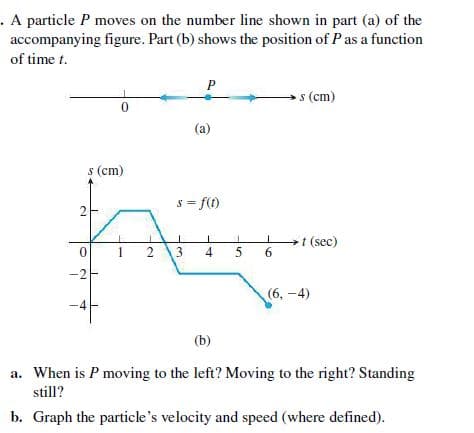. A particle P moves on the number line shown in part (a) of the accompanying figure. Part (b) shows the position of P as a function of time t. P s (cm) (a) s (cm) s = f(1) 2 t (sec) 1 6 -2 (6, -4) -4 (b) a. When is P moving to the left? Moving to the right? Standing still? b. Graph the particle's velocity and speed (where defined). 4) 2.
. A particle P moves on the number line shown in part (a) of the accompanying figure. Part (b) shows the position of P as a function of time t. P s (cm) (a) s (cm) s = f(1) 2 t (sec) 1 6 -2 (6, -4) -4 (b) a. When is P moving to the left? Moving to the right? Standing still? b. Graph the particle's velocity and speed (where defined). 4) 2.
Algebra & Trigonometry with Analytic Geometry
13th Edition
ISBN:9781133382119
Author:Swokowski
Publisher:Swokowski
Chapter3: Functions And Graphs
Section3.5: Graphs Of Functions
Problem 30E
Related questions
Question

Transcribed Image Text:. A particle P moves on the number line shown in part (a) of the
accompanying figure. Part (b) shows the position of P as a function
of time t.
P
s (cm)
(a)
s (cm)
s = f(1)
2
t (sec)
1
6
-2
(6, -4)
-4
(b)
a. When is P moving to the left? Moving to the right? Standing
still?
b. Graph the particle's velocity and speed (where defined).
4)
2.
Expert Solution
This question has been solved!
Explore an expertly crafted, step-by-step solution for a thorough understanding of key concepts.
This is a popular solution!
Trending now
This is a popular solution!
Step by step
Solved in 7 steps with 7 images

Recommended textbooks for you

Algebra & Trigonometry with Analytic Geometry
Algebra
ISBN:
9781133382119
Author:
Swokowski
Publisher:
Cengage

Algebra & Trigonometry with Analytic Geometry
Algebra
ISBN:
9781133382119
Author:
Swokowski
Publisher:
Cengage